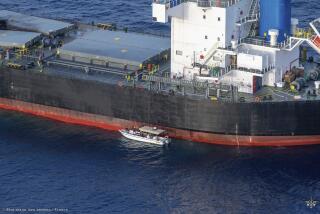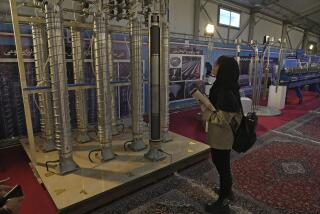Iran Said to Smuggle Material for Warheads
WASHINGTON — Iran is smuggling a highly sensitive material that could be used to encase a nuclear warhead atop a missile, a prominent Iranian exile claimed Friday.
Alireza Jafarzadeh, who helped spotlight previously unknown uranium enrichment sites in Iran nearly three years ago, said a source within the government provided evidence to him that Tehran’s Defense Ministry “has in the past and continues to smuggle” the material into the country.
The substance is a composite graphite material known as CMC, or ceramic matrix composite. Several nuclear materials experts emphasized Friday that although CMC is ideal for use on missiles with nuclear warheads, it also has roles unrelated to missiles. Some also questioned the timing of the allegations, with crucial talks between Iran and European diplomats about its nuclear program planned for next week in Paris.
Jafarzadeh, who operates a Washington consulting firm, said in a telephone interview that the material was an essential part of an Iranian government drive to develop a nuclear weapon. He also said Iran had managed to produce small quantities of CMC domestically and allocated $450 million last year to a program that could eventually make large amounts.
There was no immediate response from the regime in Tehran, which insists that it is running a nuclear program for civilian energy purposes.
The Iranian mission to the United Nations in New York did not return a telephone call seeking comment.
The graphite material’s characteristics -- it’s heat-resistant, lightweight and very strong -- make it ideal for protecting a missile’s payload during the re-entry phase of its flight, according to Gary Milhollin, director of the Wisconsin Project on Nuclear Arms Control. It also can be used for unrelated purposes, he said.
International trading of CMC for use in nuclear weapons is banned under a voluntary agreement involving more than 30 nations that is known as the Missile Technology Control Regime. Ceramic heat shields are listed in the agreement as an item of the “greatest sensitivity.”
Opponents of Iran’s government have made repeated allegations aimed mainly at exposing what they say is Tehran’s determination to build a nuclear weapon.
Although their initial claims were verified by the United Nations’ International Atomic Energy Agency and led to an international effort to halt Iran’s nuclear program, some recent charges made by regime opponents have proved false.
The timing of the current claims led some arms control specialists and regional experts to view them with caution.
“This timing is certainly no accident,” said Cliff Kupchan, a Middle East expert at the Eurasia Group in Washington. “It seems to me to be a rather transparent attempt either to detonate or complicate next week’s talks, on which the future of diplomacy could ride.
“It’s incumbent on the Iranians to refute these charges or demonstrate that the goal of these programs is not to develop a nuclear warhead,” he said.
Sig Hecker, a former director of the Los Alamos National Laboratory, said in a telephone interview Friday that even if the claims that Iran had imported CMC were true, it would not necessarily mean the material was intended for use in delivering a nuclear weapon. Ceramic matrix composites are often used in conventional weapons and armor, said Hecker, a leading metallurgist who has helped evaluate North Korea’s nuclear capability.
Although much of the recent international attention on Iran has focused on its nuclear program, the regime has worked to develop missiles that are, at least in theory, capable of delivering a nuclear weapon.
The Shahab-3 medium-range missile, derived from a North Korean design, has a range of just less than 1,000 miles.
In comments in November that raised eyebrows, then-Secretary of State Colin L. Powell said the U.S. had information that the Iranians “were working actively” on missile systems.
“You don’t have a weapon until you can put it in something that can deliver a weapon,” Powell said at the time. “We are talking about information that says they not only have missiles but information that suggests they are working hard about how to put the two together.”
Milhollin said Friday that the characteristics of Iran’s Shahab-3 missile make it better suited for delivering a nuclear payload than chemical, biological or conventional weapons.
“CMC would better enable Iran to deliver a nuclear warhead over long distances,” he said.
He emphasized that CMC was not itself a nuclear material and Iran was not obligated to report its possession to the International Atomic Energy Agency.
It “would likely have to be smuggled into Iran because no reputable manufacturer would fulfill such an order” from Tehran, he said.
Richard H. Speier, a missile technology expert who helped negotiate the Missile Technology Control Regime, called allegations of Iran smuggling CMC “plausible.”
“They’ve been smuggling in all sorts of stuff for these programs,” Speier said. “Virtually none of these proliferator countries can go it alone.”
Speier added that the importing of CMC to Iran could pose a serious proliferation threat.
Jafarzadeh said Tehran had purchased an undetermined amount of CMC from countries that have mastered the technology to manufacture the material. The shipping was often organized through Iranian front companies located in third countries, he said.
One of the companies he identified, Iranian-owned Gulf Resources Development Corp., located in the Jebel Ali free-trade zone of Dubai, United Arab Emirates, is on a U.S. watch list for possible illegal trading.
Jafarzadah said front companies were used mainly to purchase the CMC, much of which came from China. He said, however, that Chinese authorities had banned shipment in some cases when it was discovered that Iran was to be the final destination.
“There were shipments stopped in the past two months,” Jafarzadeh said.
According to the Wisconsin Project’s Risk Report, a database of suspect activities and sensitive equipment used for export control, CMC is also produced in France, Germany, India, Israel, Russia, Britain and the United States.
More to Read
Sign up for Essential California
The most important California stories and recommendations in your inbox every morning.
You may occasionally receive promotional content from the Los Angeles Times.










